
The Breed History
"Poodle" likely derives from Pudel, a German term describing one
who plays and splashes in water or puddles. The exact lines of
genetic origin are obscured, but ancient breeds such as the Irish
water spaniel, Rough haired water dog and others contribute to
the type, and perhaps the first of the smaller types of poodles
originated by crosses with terrier type for use in truffle hunting.
German history records poodle type dogs in the 15th century. The
toy version of poodle first widely entered the history record in the
18th century. Very early records in the Mediterranean place poodle
type dogs in the first century. Though often referred to as the
French poodle, the breed is not though to have originated there.
AKC recognition occurred in 1887.
Breeding for Function
Originally these dogs were bred as gundogs for waterfowl hunting,
as a water retriever. The origins of the fancy coat clips trace back
to early times when the hunters clipped the bulk of the dog coat so
that they would dry quickly, and to minimize the weight of the wet
hair for ease of swimming, but they left fur over bony prominences
to help insulate joints from the cold. In France, the dog was also
used extensively as a circus dog. Toy, miniature, and standard
poodles are all popular as companion dogs, and the smaller types
were bred down in size from the standard; it was the larger
standard poodle that was originally used for hunting. Guide dogs,
therapy dogs, police work and obedience and agility competitions
round out some of their modern functions.
Physical Characteristics
All three types share the same breed standard, only the size and
weight varies between the three.
Toy
Height at Withers: female up to 10" (25.4 cm), male up to 10"
(25.4 cm)
Weight: females 6-9 lb (2.5-4 kg), males 6-9 lb (2.5-4 kg).
Miniature
Height at Withers: female 10-15" (25.5-38 cm), male 10-15"
(25.5-38 cm)
Miniature Weight: females 15-17 lb (7-8 kg), males 15-17 lb (7-8 kg).
Standard
Height at Withers: female 15 " (38 cm) or more, male 15" (38 cm)
or more.
Standard Weight: females 45-60 lb (20-27 kg), males 45-70 lb
(20-32 kg).
Coat: All solid colors accepted (e.g., apricot, black, gray, silver, blue,
cafe-au-lait, cream) and the coat is dense, wiry and curly. If left
unclipped, it tends to form ringlets (cording) and waves. There are
specific clips used in show, and their coat is a distinguishing breed
feature.
Longevity: 12-15 years. The smaller types may reach 15-17 years
on average.
Points of Conformation: A long face, with medium-sized and
leathered triangular ears lying flat, and wide, almond-shaped
dark brown eyes, a slight stop, and fairly narrow muzzle typify the
poodle head. They possess a level topline, feet are compact and
webbed, and they have straight limbs with the dewclaws generally
removed. Tails are usually docked to one half length, and they are
proportioned to be as high as they are long. Their gait is lively and
elastic, and they move straight.
Recognized Behavior Issues and Traits
Extreme intelligence, sociability, and excellent trainability are well
known poodle traits. Very lively, they do tend to bark, and need to
be socialized to other pets and people or else they can potentially
be nippy. They need close human companionship and tend to be
aloof with strangers. They are good alarm barkers.The poodles
require regular clip and grooming (every 6-8 weeks), and are low
shedding and low allergy dogs. They tend to need more frequent
dental care. They do well in town or country and need moderate
levels of exercise. They are high activity around the house, though
the standard poodles are often less active indoors.
Normal Physiologic Variations
Echocardiographic Normal Values for Miniature Poodles:
Parameter Median/ (Range)
Weight (kg) - 3/ (1.4-9)
Heart rate (bpm) - 150/ (100-200)
LVPWD (mm) - 5/ (4-6)
LVPWS (mm) - 8/ (6-10)
LVD (mm) - 20/ (16-28)
LVS (mm) - 10/ (8-16)
FS (%) - 47/ (35-57)
EPSS (mm) - 0/ (0-2)
RVd (mm) - 4/ (2-9)
IVSd (mm) - 5/ (4-6)
IVSs (mm) - 8/ (6-10)
AOD (mm) - 10/ (8-13)
LAS (mm) - 12/ (8-18)
N - 20
LVPWD, LV posterior wall dimension at end-diastole; LVPWS, LV
posterior wall thickness at end-systole; LVD, LV chamber dimension
at end-diastole; LVS, LV chamber dimension at end-systole; FS,
percent fractional shortening; EPSS, E-point septal separation; RVD,
RV chamber dimension at end-diastole; IVSd, interventricular septal
thickness at end-diastole; IVSs, interventricular septal thickness at
end-systole; AOD, aortic root at end-diastole; LAS, left atrium at
end-systole; N, number of animals.
Drug Sensitivities
None Reported
Inherited Diseases
Hip Dysplasia: Polygenically inherited trait causing degenerative
joint disease and hip arthritis. OFA reports 12.3% affected.
Patella Luxation: Polygenically inherited laxity of patellar
ligaments, causing luxation, lameness, and later degenerative joint
disease. Treat surgically if causing clinical signs. Reported 9.7x odds
ratio in Toy Poodles, 4.1x odds ratio in Miniature Poodles, and 3.2x
odds ratio in Standard Poodles versus other breeds. OFA reports
4.4% affected.
Progressive Retinal Atrophy (PRA): Autosomal recessive
progressive rod cone degeneration (prcd) form seen in Minature
and Toy Poodles. Age of onset between 3-8 years of age, eventually
causing blindness. Optigen reports 3% testing affected, and 28%
testing carrier in Miniature Poodles, and 5% testing affected, and
29% testing carrier in Toy Poodles. Dorn reports a 9.71x odds ratio
versus other breeds. A genetic test is available.
Elbow Dysplasia: Polygenically inherited trait causing elbow
arthritis. OFA reports 2.8% affected.
Legg-Perthes Disease: Polygenically inherited aseptic necrosis
of the femoral head seen in Toy and Miniature Poodles. Causes
degenerative joint disease and hip arthritis. Usually presents
unilaterally. Reported 22.4x odds ratio in Toy Poodles, and 12.1x
odds ratio in Miniature Poodles for Legg-Calve-Perthes versus other
breeds. OFA reports 1.0% affected.
von Willebrand's Disease Type 1 (vWD): Autosomal recessive
genetic disorder causing a mild bleeding syndrome. A direct genetic
test is available from VetGen, reporting 1% affected, and 9% carrier
in the breed.
Hypoadrenocorticism (Addison's disease): Controlled by a major
autosomal recessive gene, but not a simple recessive disorder.
Immune mediated destruction of the adrenal gland seen in
Standard Poodles. Typical presentation of lethargy, poor appetite,
vomiting, weakness, and dehydration occuring from 4 months
to several years of age. Can also present with painful muscle
cramping. Treatment with DOCA injections or oral fludrocortisone.
Heritabililty of 0.75 in the breed. No genetic test is available.
Neonatal Encephalopathy: Rare, autosomal recessive disorder
causing poor growth, ataxia, whole body tremor, and tonic-clonic
seizures between 1-5 weeks of age. A genetic test is available.
Mucopolysaccharidosis VI (MPS VI): PennGen reports MPS VI
identified in the Miniature and Toy Poodle. This is an autosomal
recessive disorder causing skeletal deformities, including defects in
the sternum, vertebrae and particularly the hip joints. To varying
degrees they may also experience corneal cloudiness and facial
dysmorphia. A genetic test is available.
Disease Predispositions
Gastric Dilation/Volvulus (GDV, Bloat): Life-threatening twisting
of the stomach within the abdomen. Requires immediate veterinary
attention. There is a 25.3% lifetime risk of developing GDV in
Standard Poodles, with 6.3% of all Standard Poodles dying from the
condition.
Epiphora: Ocular tear drainage with hair staining is reportedly a
common occurrence in Toy Poodles. Can occur secondary to medial
canthal trichiasis and/or entropion. Treat by keeping hair clipped
short, and daily cleaning. Medial canthoplasty is curative in severe
cases.
Distichiasis: Abnormally placed eyelashes that irritate the cornea
and conjunctiva. Can cause secondary corneal ulceration. Identified
in 11.72% of Toy Poodles, 9.08% of Miniature Poodles, and 1.04%
of Standard Poodles CERF examined by veterinary ophthalmologists
between 2000-2005.
Cataracts: Cortical and nuclear cataracts predominate in the
breed. Reported at a frequency of 10.79% in Miniature Poodles,
10.21% in Toy Poodles, and 7.00% in Standard Poodles. Reported
at a frequency of 13.8% in Toy Poodles in Brazil. Dorn reports a
3.10x odds ratio in Standard Poodles versus other breeds. One
study showed a 6.1x odds ratio for Toy Poodles, and a 4.3x odds
ratio for Miniature Poodles versus other breeds. Mean age at onset
of 9.6 years in Miniature and Toy Pooodles. Identified in 3.95% of
Toy Poodles, 3.63% of Standard Poodles, and 2.82% of Miniature
Poodles CERF examined by veterinary ophthalmologists between
2000-2005. CERF does not recommend breeding any Poodle with a
cataract.
Periodontal Disease: Miniature and Toy Poodles are found to be
predisposed to periodontal disease and tooth loss.
Persistent Pupillary Membranes: Strands of fetal remnant
connecting; iris to iris, cornea, lens, or involving sheets of tissue.
The later three forms can impair vision, and dogs affected with
these forms should not be bred. Identified in 5.54% of Miniature
Poodles, 4.12% of Toy Poodles, and 2.08% of Standard Poodles CERF
examined by veterinary ophthalmologists between 2000-2005.
Bronchiectasis: Clinical signs of chronic cough with excessive
airway mucous. Diagnosis with radiographs. Reported at a
frequency of 5.2% and an odds ratio of 2.99x in the Miniature
Poodle, and a frequency of 2.4% and an odds ratio of 1.83x in the
Toy Poodle versus other breeds. Treatment is with bronchodilators
and possibly corticosteroids.
Hypothyroidism: Inherited autoimmune thyroiditis. 4.2% positive
for thyroid autoantibodies based on testing at Michigan State
University. (Ave. for all breeds is 7.5).
Otitis Externa (Chronic Ear Infection): Bacterial, yeast, or mixed
infections. Miniature Poodles are one of the breeds with the highest
incidence. In one study, 39.29% of dogs with Malassezia (yeast) ear
infection were Poodles.
Tracheal Collapse: Seen in Toy and Miniature Poodles. Causes
persistent "honking" cough, especially when excited. Dorn reports a
5.92x odds ratio for tracheal collapse versus other breeds. Usually
occurs in middle-aged to older dogs. Usually poorly responsive to
surgery. Many cases can be controlled medically.
Mitral Valve Disease (MVD): Elderly Miniature and Toy Poodles
are prone to mitral valvular regurgitation, at an average age of 9.
years. Can lead to congestive heart disease, cardiac arrhythmias
(irregular heartbeats) and cardiac failure. Treat with heart drugs.
Cryptorchidism (Retained Testicles): Can be unilateral or bilateral.
Reported at an increased frequency in all three varieties of Poodle;
with a significant risk in Toy Poodles, moderate risk in Miniature
Poodles, and increased risk in Standard Poodles versus other breeds.
Atrial Septal Defect (ASD): Limited echocardiographic screening
of Standard Poodles show approximately 5% affected with an
ostium secundum atrial septal defect. Some families have up to
40% of dogs affected. If small, an ASD may not produce clinical
disease. Medium to large ASD have hemodynamically significant
left to right shunting resulting in right atrial and ventricular
enlargement and clinical signs of heart failure. Screen with Doppler
echocardiography. Undetermined mode of inheritance.
Sebaceous Adenitis: Disorder of immune mediated sebaceous
gland destruction, presenting with hair loss, hyperkeratosis and
seborrhoea, usually beginning with the dorsal midline and ears.
Diagnosis by skin biopsy. Treat with isotretinoin. An autosomal
recessive mode of inheritance is suspected. Poodles are reported at
a frequency of 0.9% in Sweden. OFA reports 2.8% affected.
Idiopathic Epilepsy: Inherited Seizures can be generalized or partial
seizures. In a study of one family, 93% had focal-onset seizures
with a median age of onset of 3.7 years, an equal sex ratio, and
a possible simple autosomal mode of inheritance. In Standard
Poodles, 17.1% start as generalized seizures, and 68.3% begin as
partial seizures (with the rest mixed) at a mean age of 2.8 years.
81% of affected Standard Poodles progress to generalized seizures.
Control with anticonvulsant medications.
Diabetes Mellitus: Caused by a lack of insulin production by
the pancreas. Controlled by insulin injections, diet, and glucose
monitoring. Miniature Poodles have an odds ratio of 4.01x, and Toy
Poodles have an odds ratio of 3.27x versus other breeds.
Hyperadrenocorticism (Cushing's disease): Hyperfunction of the
adrenal gland caused by a pituitary or adrenal tumor. Clinical signs
may include increased thirst and urination, symmetrical truncal
alopecia, and abdominal distention. Reported at an increased
frequency in Poodles, representing 38.14% of all cases. Dorn reports
a 2.72x odds ratio versus other breeds.
Secondary Glaucoma: Increased intraocular pressure and blindness
can occur after cataract formation, lens luxation (predominantly
Miniature Poodles), hyphema (predominantly Toy Poodles), or uveitis
(predominantly Standard Poodles). One report found an odds ratio
of 4.7x for secondary glaucoma in Poodles.
Vitreous Degeneration: A liquefaction of the vitreous gel which
may predispose to retinal detachment and/or glaucoma. Identified
in 1.85% of Toy Poodles CERF examined by veterinary ophthalmologists
between 2000-2005.
Primary (Narrow Angle) Glaucoma: Ocular condition causing
increased pressure within the eyeball, and secondary blindness due
to damage to the retina. Diagnose with tonometry and gonioscopy.
Diagnosed in 1.68% of Miniature Poodles, 1.20% of Toy Poodles,
and 0.73% of Standard Poodles presented to veterinary teaching
hospitals. CERF does not recommend breeding any Poodle with
glaucoma.
Patent Ductus Arteriosus (PDA): Polygenically inherited
congenital heart disorder; affected dogs are usually stunted, and
have a loud heart murmur. Diagnosis is via Doppler ultrasound.
Treatment is surgical. Miniature and Toy Poodles have an increased
incidence versus other breeds.
Calcium Oxalate Urolithiasis: Miniature and Toy Poodles have a
predisposition to develop calcium oxalate bladder stones, with a
3.85x odds ratio versus other breeds.
Lens Induced Uveitis: Occurs secondary to cataract formation.
35% of all cases are in Toy and Miniature Poodles, with a mean
age of 9.0 years. One-third of cases are bilateral. Can progress to
glaucoma.
Juvenile Renal Disease: Young Standard Poodles can develop a
progressive renal dysfunction. Typically presents with increased
drinking and urination, weight loss or unthriftiness, consistently
dilute urine, and elevated kidney blood tests. Late in the disease,
affected dogs can leak urinary protein, have non-regenerative
anemia, and fibrous osteodystrophy. Onset from weeks of age to
over a year in age. Some dogs remain with mild signs, while others
rapidly progress to kidney failure. Unknown mode of inheritance.
Diagnosis by kidney biopsy or pathology.
Mammary Gland Osteosarcoma: Female Miniature Poodles have
predisposition to develop this malignant cancer, with an odds ratio
of 2.7x versus other breeds.
Alopecia-X/ Hyperadrenocorticism Associated with Sex Steroid
Excess (Black Skin Disease, BSD, Coat Funk, Severe Hair
Loss, SHL): Miniature Poodles are overrepresented. Progressive,
symmetrical, non-pruritic, truncal hair loss usually beginning in
early adulthood. ACTH stimulation test, low-dose dexamethazone
suppression test, and thyroid panel results are normal. Alkaline
phosphatase and ALT are elevated. Urinary corticoid:creatinine
ratio may be normal to elevated. Elevated blood concentrations
of 17-hydroxyprogesterone (17-OHP) have been seen post ACTH
stimulation. Oral trilostane reverses the condition in some cases.
The disorder appears familial, with a male predilection.
Dilated Cardiomyopathy: Can present with ventricular
arrhythmias, leading to cardiac dilation and heart failure. Increased
incidence reported in Standard Poodles. There is a two to one ratio
of affected males to females.
Perineal Hernia: Miniature Poodles have a predisposition to
developing perineal hernias. Treatment is surgery.
Optic Nerve Hypoplasia/Micropapilla: Failure of development
of the optic nerve. Identified in 0.90% of Miniature Poodles CERF
examined by veterinary ophthalmologists between 2000-2005. CERF
does not recommend breeding any Poodle with the condition.
Digital Squamous Cell Carcinoma (SCC): Subungual squamous
cell carcinoma occurs at increased frequency in black dogs. Treat
with digital amputation. Standard Poodles account for 14.3% of all
cases.
Shoulder Instability: In a one study, the most frequent breed was
Standard Poodles, representing 13% of all cases. Clinical signs
included pain and muscle atrophy. Surgerical stabilization provided
the best outcome.
Lingual Squamous Cell Carcinoma (SCC): Poodles have a 4.61x
odds ratio versus other breeds of developing this cancer. Females
are overrepresented in one study.
Degenerative Myelopathy (DM): Identified as a rare disorder
in Standard Poodles, though Miniature Poodles have also been
pathologically diagnosed. Affected dogs show an insidious onset
of upper motor neuron (UMN) paraparesis at an average age of
11.4 years. The disease eventually progresses to severe tetraparesis.
Affected dogs have normal results on myelography, MRI, and CSF
analysis. Necropsy confirms the condition. Unknown mode of
inheritance. A direct genetic test for an autosomal recessive DM
susceptibility gene is available from OFA showing 17% carrier and
1% homozygous genes "at risk" in Poodles. All affected dogs are
homozygous for the gene, however, only a small percentage of
homozygous dogs develop DM.
Atresia Ani (Imperforate Anus): An increased incidence of this
congenital condition is reported in Miniature and Toy Poodles, with a
frequency of 0.02%, and an odds ratio of 4.28x. Treatment is surgery.
Polymicrogyria: Affected Standard Poodles present between 7
weeks and 4 months of age with clinical signs that can include
blindness, behavior changes, hypermetric gait, complex partial
motor seizures, delayed proprioceptive hopping, and resting
nystagmus. (1/5), and decreased pupillary light response. Some
dogs also demonstrated progressive aggression toward the owner.
EEG readings were abnormal. Imaging, and gross and histological
examination revealed polymicrogyria that variously involved
the occipital, temporal, or entire cerebral lobes of the brain.
Undetermined mode of inheritance.
Allergic Inhalant Dermatitis, Anterior Crossbite, Base-Narrow
Canines, Brachygnathism, Cerebellar Abiotrophy, Ceroid
Lipofuscinosis, Corneal Dystrophy, Cystinuria, Deafness,
Entropion, Factor VIII Deficiency, Factor XII Deficiency, Fibrinoid
Leukodystrophy, Globoid Cell Leukodystrophy, Growth Hormone
Responsive Dermatosis, Hemeralopia, Hydrocephalus, Ichthyosis,
Intervertebral Disc Disease, Keratoconjunctivits Sicca, Lafora
Body Disease, Leukodystrophy Lymphedemamacrocytosis/
Dyshematopoiesis, Methemaglobin Reductase Deficiency,
Microphthalmia, Osteogenesis Imperfecta, Narcolepsy,
Nodular Panniculitis, Oligodontia, Pancreatitis, Prognathism,
Prolapsed Nictitans, Proliferative Episcleritis, Prekallikrein
Deficiency, Pseudohermaphrodism, Retinal Dysplasia, Shoulder
Osteochondritis Dessicans, Sphingomyelinosis, Tetralogy of
Fallot, Vertebral Stenosis, and Wry Mouth are reported.
Isolated Case Studies
Chronic Hepatitis: Three related Standard Poodles with chronic
liver disease were pathologically diagnosed with lobular dissecting
hepatitis.
Nonspherocytic Hemolytic Anemia: A family of Miniature Poodles
developed nonspherocytic hemolytic anemia, marked reticulocytosis,
hepatosplenomegaly, hemosiderosis of reticuloendothelial
organs, bone marrow myelofibrosis, and osteosclerosis by 1 year of
age. The disease was fatal by 3 years of age. A pathogenesis was not
determined.
Congenital Ectodermal Defect: X-linked recessive disorder
reported in male Miniature Poodle siblings. Affected dogs are born
without hair (hypotrichosis), have a reduced number or absence of
sweat glands, and missing or malformed teeth.
Amelogenesis Imperfecta/Familial Enamel Defect: A multi-generational
family of Standard Poodles in Sweden was identified with
discolored teeth due to enamel malformation. Defective enamel
mineralization was documented histologically.
Junctional Epidermolysis Bullosa: A newborn Toy Poodle
developed vesicles and bullae on the pads of the feet, oral mucous
membranes, and skin if the ventral abdomen. The lesions progressed
rapidly, and the pup was euthanized on day 2.
Genetic Tests
Tests of Genotype: Direct test for pcrd-PRA is available from
Optigen.
Direct test for von Willebrand's disease (vWD) is available from
VetGen
Direct test for neonatal encephalopathy is available from the OFA.
A direct test for an autosomal recessive DM susceptibility gene is
available from the OFA.
Direct test for MPS is available from PennGen.
Direct tests for black, brown, cream, white, red, and apricot coat
colors, and black and brown nose are available from HealthGene
and VetGen.
Tests of Phenotype: Miniature Poodles: CHIC Certification:
Required testing includes hip radiographs, CERF eye examination,
direct test for prcd-PRA, and patella evaluation. (See CHIC website;
caninehealthinfo.org).
Recommend thyroid profile including autoantibodies, elbow
radiographs, and cardiac evaluation.
Standard Poodles: CHIC Certification: Required testing includes hip radiographs, CERF eye examination, and one of the following:
thyroid profile including autoantibodies, biopsy for sebaceous
adenitis, or cardiac evaluation including echocardiogram. (See CHIC
website; caninehealthinfo.org).
Recommend elbow radiographs and patella evaluation.
Toy Poodles: CHIC Certification: Required testing includes CERF
eye examination, patella evaluation, and direct test for prcd-PRA.
(See CHIC website; caninehealthinfo.org).
Recommend hip and elbow radiographs, thyroid profile including
autoantibodies, and cardiac evaluation.
Miscellaneous
- Breed name synonyms: Pudel, Toy Poodle, Caniche, Chien Canne,
Standard Poodle. Barbone, French duck dog, French Poodle, Toy
Poodle, Miniature Poodle.
- Registries: AKC, UKC, CKC, KCGB (Kennel Club of Great Britain),
ANKC(Australian National Kennel Club), NKC (National Kennel Club)
- AKC rank (year 2008): 9 (21,545 dogs registered)
- Internet resources: The Poodle Club of America:
poodleclubofamerica.org
Poodle Club of Canada: poodleclubcanada.com
The Standard Poodle Club (UK): standardpoodleclub.com
The Miniature Poodle Club (UK):
miniaturepoodleclub.org.uk
Photo Gallery of Breed - Poodle - Dog Breed
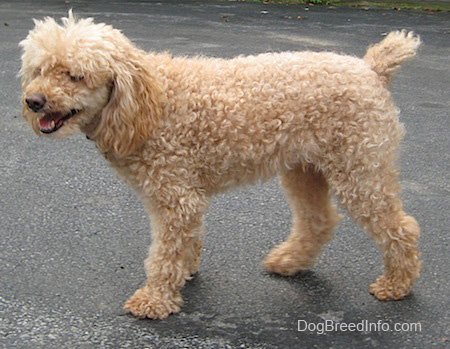
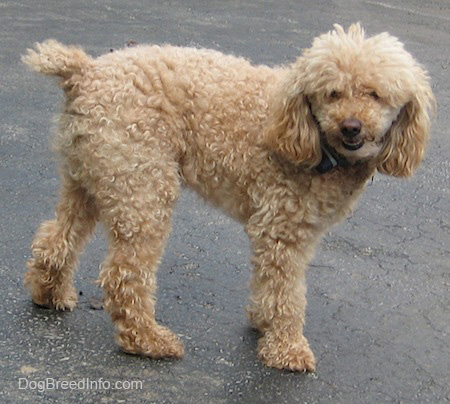


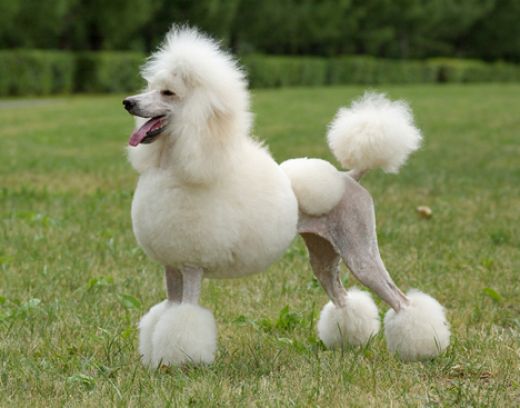

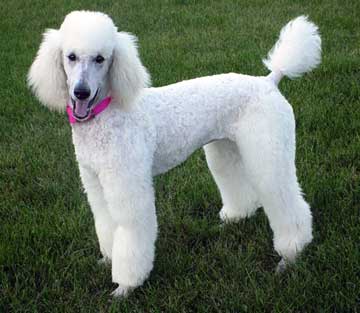
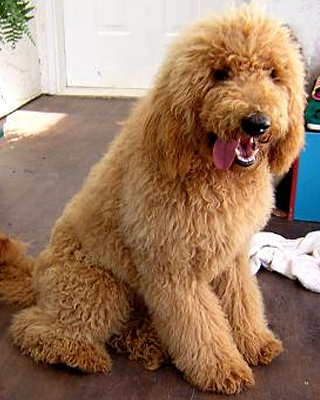
 Animalia Life
Animalia Life